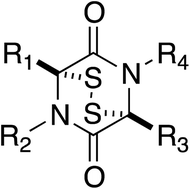Epidithiodioxopiperazines. occurrence, synthesis and biogenesis
Abstract
Covering: 1936 to 2013
Epidithiodioxopiperazine alkaloids possess an astonishing array of molecular architecture and generally exhibit potent biological activity. Nearly twenty distinct families have been isolated and characterized since the seminal discovery of gliotoxin in 1936. Numerous biosynthetic investigations offer a glimpse at the relative ease with which Nature is able to assemble this class of molecules, while providing synthetic chemists inspiration for the development of more efficient syntheses. Herein, we discuss the isolation and characterization, proposed fungal biogeneses, and total syntheses of epidithiodioxopiperazines.

- This article is part of the themed collection: Fungal Natural Products

 Please wait while we load your content...
Please wait while we load your content...